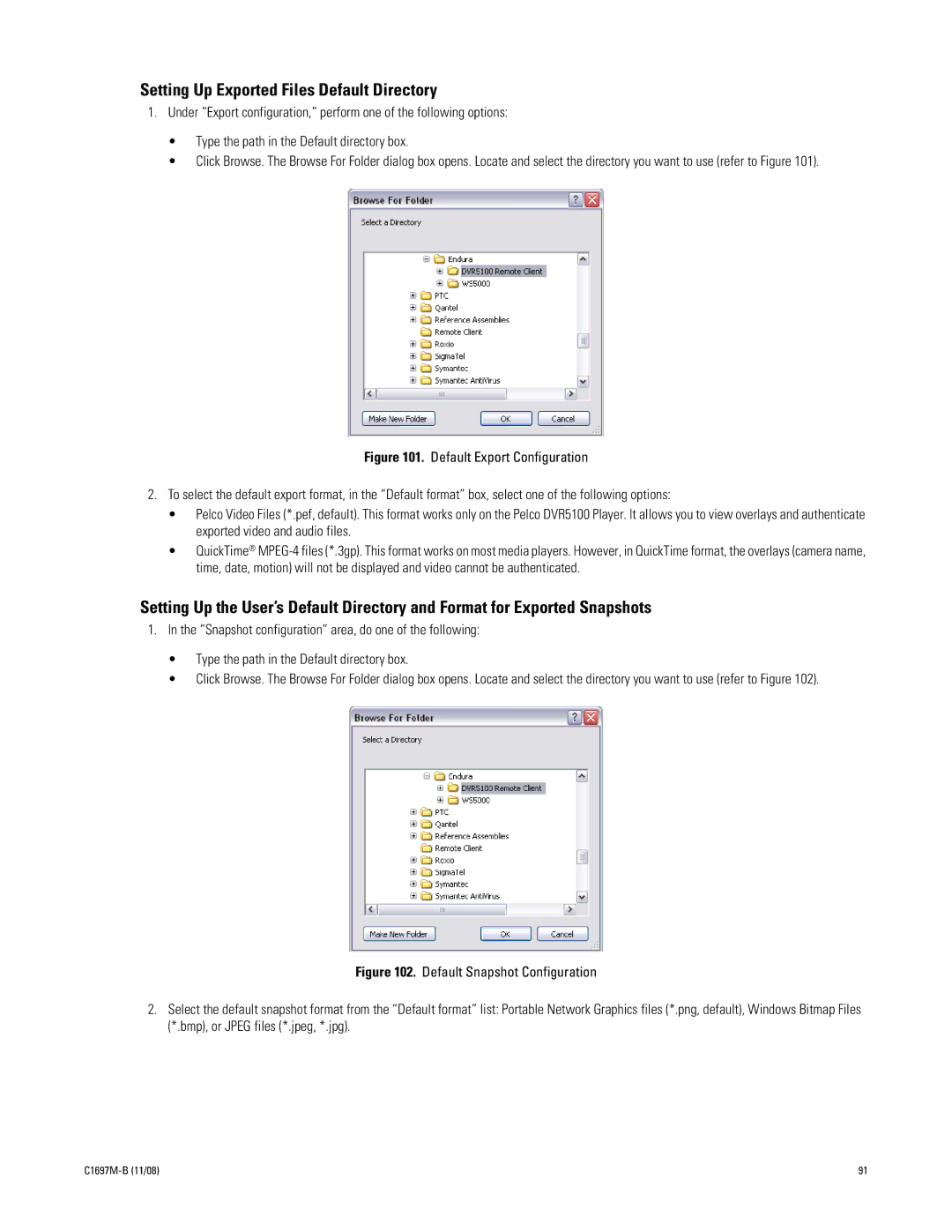DVR5100 Series Hybrid Video Recorder
Page
Contents
Managing Exported Video
Setting Service Permissions
List of Illustrations
C1697M-B 11/08
Page
List of Tables
Function DVR5100 Remote Client
Welcome
Close all programs, including any antivirus software
Installing the Remote Client
Installing the Remote Client Application
Minimum System Requirements
Getting Started
Setting UP Server Connections
Creating a NEW Connection
Dialog Box
Logging on
8 layout
Main Application Window Overview
C1697M-B 11/08
Keyboard Shortcuts
Remote Client Controls and Shortcuts
Tooltips
Shortcut Menus
Monitoring Live Video and Audio
Operating the Remote Client
Selecting Video to Display
Filtering the Camera View
Disconnecting Cameras
Using Filters to Limit the Camera List
To set up a filter
Removing Camera Locations and Group Filters
Navigation Explorer View, Sorted by Camera Number
Arranging Cameras in the Explorer View
Icon Description
Video Controls
Adjusting the Iris
Using Digital Zoom Controls
Adjusting the Focus
Digital Zoom Controls
Controlling PTZ Cameras
Presets
Using PATTERNS, PRESETS, and Scans
Patterns
To scan is to view an area by automatically panning a camera
Scans
Rotate the Camera
Stopping a Scan
Zoom In and Out
Motion Detection
Activating the Wiper Command
Click OK to close this screen
Device Properties and Settings
Viewing Device Properties
Viewing Advanced Device Properties
Viewing Diagnostic Properties
Camera Settings
DVR5100 can be queried for diagnostic information
Accessing a Camera Menu
Using Camera Menus
Exiting a Camera Menu
Action Description
Executing Scripts
Stopping a Script
Activating a Script Manually
Working with Alarms
Alarms, Relays, and Manual Recording
Reading Alarm Comments
Alarm Notification
Acknowledging AN Alarm
Snoozing AN Alarm
Sending ALL Associated Cameras to the Workspace
Adding a Note to the System LOG
C1697M-B 11/08
Activating a Relay
Activating Relays
Manually Recording a Video Segment
Manually Recording Video and Audio
Stopping a Manual Recording
Quick Search
Searching for Video
Perform one of the following options
Performing AN Enhanced Search
Enhanced Search
Scroll backward by rotating your mouse wheel Click zoom out
Enhanced Search Filters Area
To specify the time range manually, do one of the following
Removing Cameras
Specifying Cameras AS Search Criteria
Reviewing Enhanced Search Results
Specifying Recording Type Filters
Unlocking a Search Result
Locking and Unlocking Search Results
Printing Enhanced Search Results
Locking a Search Result
Playing Back Video
Number of Clicks Speed
Standard Playback
4X normal speed 15X normal speed 60X normal speed
Synchronous Playback
Synchronous Playback
Stopping AN Export Process
Exporting Video
Exporting Live or Recorded Video
Starting AN Export Process
Exporting Recorded Video During Playback
Go to Live Command
Capturing and Exporting Snapshots
Exporting ALL Video Frames
Capturing a Snapshot
Managing Exported Video
C1697M-B 11/08
Logged Main Events Logged Sub Events
Working with System Logs
Searching the System LOG
Viewing the System LOG
Click Search Log
C1697M-B 11/08
Exporting a System LOG
Printing a System LOG
Adding Manual LOG Entries
Remote Client Setup Screen
Setup Using the Remote Client
Icon Device Type
Configuring Devices
AlarmArray Camera
Selecting a Device
Restoring Device Defaults
Copying Device Settings
Naming Devices
Assigning a Device Location
Table H. Devices
Working with Devices
Device Icon Description
Working with the General TAB
Cameras
Selecting Video Termination
Operating a Camera in Covert Mode
Creating a Camera Group
Selecting a Camera Group
Adding Cameras to a Camera Group
Modifying a Camera Group Name
Deleting a Camera Group
Camera Association
Setting Up Audio Associations
Setting the Noise Filter
Working with the Configuration TAB
Configuring the Camera Settings
Understanding the Motion Threshold
Working with the Motion TAB
Option Description
Understanding the Threshold Percent
Motion Zone and Threshold Blocks Example
Blocks. These values are derived as follows
Click Clear. All three motion zones are cleared
Setting Up Motion Detection
Clearing Motion Detection Settings
Working with the Audio TAB
Enabling Audio Service
Accessing DVR Options
Setting UP the Serial Port
Alarm Array
Specifying the DVR Name and Location
Creating AN Alarm Input Name
Accessing Alarm Array Options
Modifying the Alarm Array Device Name
Specifying Alarm Array Location
Setting Alarm Response Characteristics
Specifying AN Alarm Input Location
Setting AN Alarm Input Polarity and Dwell Time
Relay Array
Accessing Relay Array Options
Modifying the Relay Array Device Name
Specifying a Relay Array Location
Setting Relay Output Characteristics
Accessing the System Logger Options
System Logger
Modifying the System Logger Device Name
Setting the Pruning Period
Selecting the LOG Level
Option Label Default Value Role Administrator
Using a Default Role
Administrator
Maximum Level of Access
Option Label
Option Label Default Value
Manager
Operator
Adding a NEW Role
Table M. Operator Role Default Settings Sheet 2
Guest
Assigning Permissions
Assigning Permissions to System Features
Selecting Services
Setting Service Permissions
Setting Device Permissions
Deleting a Role
Excluding Devices and Services
Adding NEW Users
Managing Users
Assigning a Role to a User
Selecting User Notification Preferences
Viewing User Permissions
Displaying the Time Zone
Setting UP Export and Snapshot Defaults
Setting Up Exported Files Default Directory
Removing Users
Editing Default User Settings
Adding a NEW Event Group
Configuring Event Groups
Deleting AN Event Group
Setting PRE- and POST-ALARM Video Recording Times
Recording Schedule Screen
Recording Schedule Setup
Clearing a Weekday Schedule
Deleting a Recording Schedule
Creating a Recording Schedule
Copying and Reusing a Recording Schedule
Modifying a Recording Schedule
Global Settings
Recording Storage Setup
Estimated Storage
Endurastor Settings
Privacy Settings
Estimated Alarm Video
Adding a Script
Creating Scripts
Modifying Script Content
104 C1697M-B 11/08
Modifying a Script Schedule
Deleting a Script
Playing Back Exported Files
Accessing Exported Files
Tools Setup
Working with the Endura Player
Volume Control
Opening a File
Authenticating a File
ON-SCREEN Playback Controls
Authentication Succeeded
Exported File Properties
112 C1697M-B 11/08
Go to Tools Setup. a dialog box appears
Modifying Player Settings
Player with Motion Overlays
Using Extended View
Index
Setting up 69 notification
Features, access to 81 filters Camera
Access to devices, limiting 86 assigning
Selecting devices 90 permissions, viewing 89 profile
Preconfigured Service permissions, setting
Unlock video 81 unsupervised alarm mode 75 user
Activating 27 script
Page
Product Warranty and Return Information

